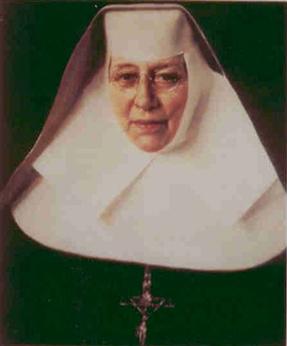
The Metropolitan Archdiocese of Dubuque is a Latin Church ecclesiastical territory or archdiocese of the Catholic Church in the northeastern quarter of the state of Iowa in the United States.

The Shrine of the Grotto of the Redemption is a religious shrine in West Bend, Iowa, in the Roman Catholic Diocese of Sioux City. A conglomeration of nine grottos depicting scenes in the life of Jesus, it contains a large collection of minerals and petrifications and is believed to be the largest grotto in the world.
The Franciscan Sisters of Christian Charity are a Congregation of Roman Catholic apostolic religious women. The congregation was founded in 1869 in Manitowoc, Wisconsin in the Roman Catholic Archdiocese of Milwaukee, later part of the Roman Catholic Diocese of Green Bay. The sisters have active apostolates in education, health care, spiritual direction, and other community ministries. As of 2021, there are 188 sisters in the community. The FSCC is a member of the Council of Major Superiors of Women Religious, an organization which represents women religious in the United States.

Katharine Drexel, SBS was an American Catholic religious sister, and educator. In 1891, she founded the Sisters of the Blessed Sacrament, a religious congregation serving Black and Indigenous Americans.

John Hennessy was a 19th-century Irish-born prelate of the Roman Catholic Church who served as bishop and archbishop in the United States. He served as bishop and then the first archbishop of the Archdiocese of Dubuque, Iowa, from 1866 to 1900.

The Roman Catholic Diocese of La Crosse is a Latin Church diocese in west-central Wisconsin in the United States. The metropolitan for the diocese is the Archdiocese of Milwaukee. The mother church is the Cathedral of Saint Joseph the Workman in La Crosse.

The Franciscan Sisters of Perpetual Adoration (FSPA) is a Roman Catholic religious congregation for women whose motherhouse, St. Rose of Viterbo Convent, is in La Crosse, Wisconsin, in the Diocese of La Crosse. The Franciscan Sisters of Perpetual Adoration founded Viterbo University and staffed Aquinas High School in La Crosse. The congregation traces its roots to 1849.

Kilian Caspar Flasch was a German-born prelate of the Roman Catholic Church who served as bishop of the Diocese of La Crosse in Wisconsin from 1881 until his death in 1891.

Saint Francis de Sales Seminary is a seminary for the Roman Catholic Archdiocese of Milwaukee, located in the Milwaukee suburb of St. Francis, Wisconsin. Its main building, called Henni Hall, is listed on the National Register of Historic Places.

The Dickeyville Grotto is a series of grottos and shrines in Dickeyville, Grant County, Wisconsin, United States. It is located at the intersection of U.S. Highway 151 and U.S. Highway 61. Most of the site's concrete structures are covered in shells, stones, tiles, wood, glass, gems and geodes donated by area parishioners. The site is visited by 40,000 to 60,000 visitors per year.
The Sisters of St. Francis of Assisi is a Catholic religious congregation for women founded in 1849. The motherhouse is in St. Francis, Wisconsin, in the Archdiocese of Milwaukee.

The Assumption of the Blessed Virgin Mary Church is a Catholic church of the Archdiocese of Detroit located at 13770 Gratiot Avenue in Detroit, Michigan. It is commonly known as the Assumption Grotto Church. The church community was founded in the 1830s, and the present building completed in 1929, designated a Michigan State Historic Site in 1990 and listed on the National Register of Historic Places in 1991.

St. Mary Roman Catholic Church, formally the Church of the Immaculate Conception of the Blessed Virgin Mary, is in the third oldest Roman Catholic parish in Detroit, Michigan. Designed by German-born Peter Dederichs and built for the formerly ethnic German parish of the 19th century, it is located at 646 Monroe Street in what is now considered the heart of the Greektown Historic District in downtown Detroit. It is often called "Old St. Mary's Church" to avoid confusion with other St. Mary's parishes: in the Redford neighborhood of Detroit, or in nearby Royal Oak, Monroe, or Wayne.

A Lourdes grotto is a replica of the grotto where the Lourdes apparitions occurred in 1858, in the town of Lourdes in France, now part of the sanctuary of Our Lady of Lourdes. Some Lourdes grottos are almost identical reproductions of the scene of the apparitions, with statues of Our Lady of Lourdes and Bernadette Soubirous in a natural or artificial cave, while others may differ from the original in size, shape or style.
Adolphus Druiding (1838–1900) was a German-born American architect who was best known for his work in creating Roman Catholic churches, schools, rectories and convents. Druiding’s work along with that of fellow German immigrant Franz Georg Himpler (1833–1916) makes up the largest body of German Catholic architecture in the United States between the end of the Civil War and 1900.
Mollie Jenson (1890-1973) was an American sculptor from River Falls, Wisconsin. She was the creator of a series of folk art sculptures known collectively as Mollie Jenson’s Art Exhibit. Her work is an example of outsider art and vernacular architecture.

Seminary Woods is a historic woodland in St. Francis, Wisconsin, on the grounds of Saint Francis de Sales Seminary. It is one of the last surviving beech-maple mesic forests in Wisconsin. The forest was founded in 1855 when the seminary moved to St. Francis from Milwaukee and the land that was originally purchased by the Lake Drive Franciscan Sisters became part of the newly established seminary. The forest consists of 68 acres and is located near Lake Michigan. It attracts attention from naturalists for the forest's beech-maple composition and wild flowers that bloom in the spring. A striking feature of the forest is the seminary's cemetery that lies hidden among the trees.














